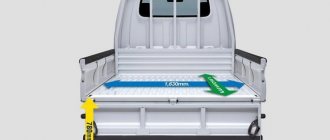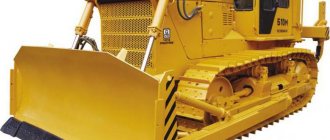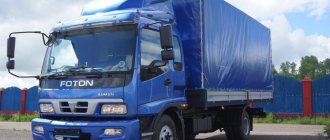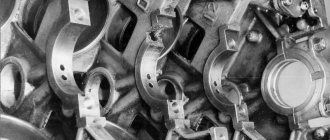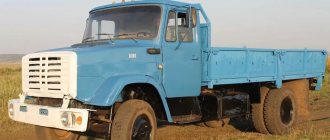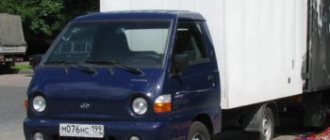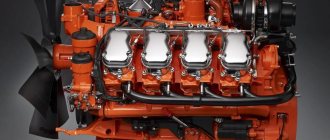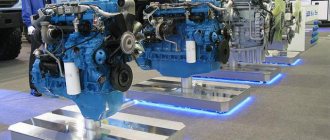The Porter small truck is a typical example of the evolution of the automobile model. The progenitor appeared in 1977 (Delica). "Porter" was produced at one time in Malaysia, Pakistan, Russia and Brazil. The car has a classic design. It is based on a frame, has a solid rear axle, a double wishbone at the front, and springs at the rear. The maximum configuration includes air conditioning, full power accessories, the “base” includes power steering, tilt adjustment, and seating for two passengers.
Porter's drive is always strictly rear-wheel drive. There are two options for carrying capacity (950 kg and 1.25 t). If the load capacity is more than a ton, then a small-diameter twin is installed at the rear. Hyundai Porter can be equipped from the factory with an onboard platform, a tilt body, an electric manipulator, a refrigeration unit, and a classic van. It must be said right away that two generations of the car will be described below (third and fourth). The first two generations do not exist, this is done in order to correspond to the progenitor.
Description of the D4BF engine
D4BF engine for Hyundai Porter
Production of the power unit began in May 1986, when it was installed under the hood of the Mitsubishi Pajero. It replaced the 4D55, representing a revolutionary configuration at that time:
- cast iron cylinder block, in-line 4-cylinder design and layout;
- durable forged crankshaft with two balancing shafts;
- Cylinder head with compact combustion chambers and one camshaft.
The first modifications of this engine were atmospheric. They developed 74 hp. With. at 4200 rpm. The Hyundai company, flattered by such indicators, adopted the engine and installed it under the hood of its cars of a suitable class. After this, the Mitsubishi Motors concern began producing more powerful engines in the series - turbocharged ones. An MHI TD04-11G was used as a supercharger, which made it possible to strengthen the unit to 90 hp. With. At the same time, Hyundai produced a turbo analogue under the designation D4BF, but with a different supercharger.
After adding an intercooler to the engine design, the power of the unit increased to 104 hp. With. This is another modification - D4BH. A model with a Bosch Common Rail and a more efficient turbine appeared in 2001. The latest pistons were used here, and the compression ratio was reduced to 17 units. Thus, it was possible to increase the power to 114 hp. With. Models of power units began to be designated as DiD and meet Euro-3 environmental standards.
Since 2005, modifications with DOHC type cylinder heads began to be produced. The 2nd generation Common Rail system was used on this engine. There were two such versions: one with an IHI RHF4 turbine, the other with the same turbine, but with variable geometry. The first option produced 136 hp. s., the second - and even more - 178 liters. With. The exhaust emissions of both engines complied with the latest Euro standards.
The D4BF engine was replaced by 4N15 in 2015
1996 was marked by the removal of the D4BF engine from production. Mitsubishi replaced it with the 4M40, but only partially. Production of the legendary engine continued, but only for certain cars and a number of countries. It was completely replaced in 2015 by 4N15.
Should I take it or not?
All the features of the machine have been outlined above; everyone can draw their own conclusions. Also in favor of the Hyundai Porter is the variety of its designs. If the choice fell on this “Korean”, then you need to understand that finding a “live” version of a commercial vehicle on the market for a small amount is not so easy. This is difficult to do, but it is possible. You don’t have to look at the mileage; it’s more important to correctly assess the condition of the entire car and its most important components. It’s better to do a little searching and overpay a little for diagnostics than to end up with expensive repairs later.
Second generation Hyundai Porter
From time to time, the Hyundai Porter will require minor repairs in any case, but this is not critical or too serious. You can almost always do such work yourself if you have the necessary tools and skills.
D4BF Maintenance Schedule
Here are the mandatory works included in the maintenance list:
- This engine needs valve adjustments every 15 thousand kilometers;
- After every 30-35 thousand kilometers, the EGR valve must be cleaned;
- Every 2 years it is necessary to update the timing belt, otherwise the risk of the unit breaking with ongoing destruction of the rockers increases;
- After 95 thousand kilometers, replace the belts of auxiliary units and balancer shafts. These belts should be checked every 40-50 thousand kilometers. A break threatens with pieces getting under the timing drive, with known consequences.
Maintenance of the D4BF motor must be carried out promptly
With normal, competent maintenance, this engine can last 400 thousand kilometers or more.
Review of faults and methods for repairing them
A number of characteristic faults distinguish this motor:
- Extraneous noise, which is most often associated with the crankshaft pulley. It’s time to change the part at this stage;
- Oil leaks, which are primarily due to a worn valve cover gasket or failed balancer seals. If everything is in order with these seals, you need to pay attention to the camshaft seal, pan gasket or oil sensor;
- Antifreeze is boiling in the tank, which indicates cracks in the cylinder head. A new head must be installed;
- The unit smokes heavily, which is explained by poor fuel combustion. The problem is usually found in damaged injector nozzles. With such a malfunction, a strong smell of diesel fuel is felt in the cabin.
Thus, the main causes of breakdowns are:
- difficult operating conditions, when design flaws make themselves felt;
- poor quality maintenance and non-compliance with operating rules;
- use of low-quality diesel fuel;
- natural wear and tear after a certain mileage, when the service life of a particular part ends.
The D4BF engine has its own characteristic faults
List of car models in which it was installed
One of the commercial segment vehicles in which the D4BF was installed was the Hyundai Porter. The car maneuvers excellently in the metropolis, despite its large dead weight.
Another car that is equipped with this engine is the Galloper. This is no longer a truck, but a multifunctional jeep. Therefore, D4BF found two solutions here: a regular aspirated engine and a turbo version. The difference in power between both engines is 25-30 hp. With. And the most surprising thing is that diesel fuel consumption essentially does not increase. For example, a Galloper gets a little more mileage than a compact Porter truck.
Here is a list of all Hyundais in which the D4BF was installed:
- Galloper;
- Grace;
- Porter;
- Starex;
- Terracan.
Hyundai Galloper has D4BF installed under the hood
Cooling system for Porter 2 in the catalog
Click on the blue number in the picture
| Name | Catalog number | Price |
| Fastening Bolt 1125406166B Solaris Solaris | 1125406166B | 20 |
| Fastening Bolt 1125406166B Solaris Solaris | 1125406166B | 20 |
| Fastening Bolt 1125406166B Solaris Solaris | 1125406166B | 20 |
| Fastening Bolt 1125406166B Solaris Solaris | 1125406166B | 20 |
| Bolt M6 1130006306B Solaris Solaris | 1130006306B | 20 |
| Bolt M6 1130006306B Solaris Solaris | 1130006306B | 20 |
| Screw 1249205123 Solaris Solaris Porter Porter | 1249205123 | 20 |
| Screw 1249205123 Solaris Solaris Porter Porter | 1249205123 | 20 |
| Screw 1249205123 Solaris Solaris Porter Porter | 1249205123 | 20 |
| Screw 1249205123 Solaris Solaris Porter Porter | 1249205123 | 20 |
| Cooling System Hose Clamp 1799325000 Solaris Solaris | 1799325000 | 30 |
| Cooling System Hose Clamp 1799325000 Solaris Solaris | 1799325000 | 30 |
| Radiator Cap Sticker 253282E000 Solaris Solaris | 253282E000 | 150 |
| Radiator Cap Sticker 253282E000 Solaris Solaris | 253282E000 | 150 |
| Radiator Cap 2533033001/2533017000 Porter Porter Hd78 | 2533017000 | 479 |
| Radiator Cap 2533033001/2533017000 Porter Porter Hd78 | 2533017000 | 479 |
| Radiator Cap 2533033001/2533017000 Porter Porter Hd78 | 2533017000 | 479 |
| Radiator Cap 2533033001/2533017000 Porter Porter Hd78 | 2533017000 | 479 |
| Radiator Cap Starex 253301P000/253303K000/Pxnda002P_Oem Porter2 Porter2 Bongo3 Suzuki | 253303K000 | 319 |
| Radiator Cap Starex 253301P000/253303K000/Pxnda002P_Oem Porter2 Porter2 Bongo3 Suzuki | 253303K000 | 319 |
| Radiator Cap Starex 253301P000/253303K000/Amdktw11_Oem Starex Porter2 Porter2 Bongo3 | 253303K000 | 327 |
| Radiator Cap Starex 253301P000/253303K000/Amdktw11_Oem Starex Porter2 Porter2 Bongo3 | 253303K000 | 327 |
| Radiator Cap Starex 253301P000/253303K000/_Oem Starex Porter2 Porter2 Bongo3 | 253303K000 | 359 |
| Radiator Cap Starex 253301P000/253303K000/_Oem Starex Porter2 Porter2 Bongo3 | 253303K000 | 359 |
| Radiator Cap Starex 253301P000/253303K000 Starex Porter2 Porter2 Bongo | 253303K000 | 557 |
| Radiator Cap Starex 253301P000/253303K000 Starex Porter2 Porter2 Bongo | 253303K000 | 557 |
| Lower Radiator Pipe Clamp 253313D044 Solaris Solaris | 253313D044 | 110 |
| Lower Radiator Pipe Clamp 253313D044 Solaris Solaris | 253313D044 | 110 |
| Lower Radiator Pipe Clamp 253313D044 Solaris Solaris | 253313D044 | 110 |
| Lower Radiator Pipe Clamp 253313D044 Solaris Solaris | 253313D044 | 110 |
| Lower Radiator Pipe Clamp 253313D044 Solaris Solaris | 253313D044 | 110 |
| Lower Radiator Pipe Clamp 253313D044 Solaris Solaris | 253313D044 | 110 |
| Lower Radiator Pipe Clamp 253313D044 Solaris Solaris | 253313D044 | 110 |
| Lower Radiator Pipe Clamp 253313D044 Solaris Solaris | 253313D044 | 110 |
| Lower Radiator Pipe Clamp 253313D044 Solaris Solaris | 253313D044 | 110 |
| Lower Radiator Pipe Clamp 253313D044 Solaris Solaris | 253313D044 | 110 |
| Lower Radiator Pipe Clamp 253313D044 Solaris Solaris | 253313D044 | 110 |
| Lower Radiator Pipe Clamp 253313D044 Solaris Solaris | 253313D044 | 110 |
| Lower Radiator Pipe Clamp 253313D044 Solaris Solaris | 253313D044 | 110 |
| Lower Radiator Pipe Clamp 253313D044 Solaris Solaris | 253313D044 | 110 |
| Lower Radiator Pipe Clamp 253313D044 Solaris Solaris | 253313D044 | 110 |
| Lower Radiator Pipe Clamp 253313D044 Solaris Solaris | 253313D044 | 110 |
| Radiator Pipe Lower 254104F150 Porter2 Porter2 | 254104F150 | 627 |
| Radiator Pipe Lower 254104F150 Porter2 Porter2 | 254104F150 | 627 |
| Radiator Pipe Lower 254104F150 Porter2 Porter2 | 254104F150 | 627 |
| Radiator Pipe Lower 254104F150 Porter2 Porter2 | 254104F150 | 627 |
| Radiator Hose Upper 254114F100_Oem Porter2 Porter2 | 254114F100 | 591 |
| Radiator Hose Upper 254114F100_Oem Porter2 Porter2 | 254114F100 | 591 |
| Radiator Hose Upper 254114F100_Oem Porter2 Porter2 | 254114F100 | 591 |
| Radiator Hose Upper 254114F100_Oem Porter2 Porter2 | 254114F100 | 591 |
| Expansion tank 254294F100 Porter2 Porter2 | 254294F100 | 890 |
| Expansion tank 254294F100 Porter2 Porter2 | 254294F100 | 890 |
| Expansion tank 254294F100 Porter2 Porter2 | 254294F100 | 890 |
| Expansion tank 254294F100 Porter2 Porter2 | 254294F100 | 890 |
| Expansion tank cap 2544126100 Santa Fe Porter2 Porter2 Starex Starex | 2544126100 | 105 |
| Expansion tank cap 2544126100 Santa Fe Porter2 Porter2 Starex Starex | 2544126100 | 105 |
| Expansion tank cap 2544126100 Santa Fe Porter2 Porter2 Starex Starex | 2544126100 | 105 |
| Expansion tank cap 2544126100 Santa Fe Porter2 Porter2 Starex Starex | 2544126100 | 105 |
| Expansion Tank Cover Gasket 2544226100 Santa Fe Porter2 Porter2 | 2544226100 | 40 |
| Expansion Tank Cover Gasket 2544226100 Santa Fe Porter2 Porter2 | 2544226100 | 40 |
| Expansion Tank Cover Gasket 2544226100 Santa Fe Porter2 Porter2 | 2544226100 | 40 |
| Expansion Tank Cover Gasket 2544226100 Santa Fe Porter2 Porter2 | 2544226100 | 40 |
| Air Conditioning Radiator 976064F100_Oem Halla Porter2 Porter2 | 976064F100 | 14715 |
| Air Conditioning Radiator 976064F100_Oem Halla Porter2 Porter2 | 976064F100 | 14715 |
| O-Ring Air Conditioner Tube 9769034310 Porter Porter Starex | 9769034310 | 127 |
| O-Ring Air Conditioner Tube 9769034310 Porter Porter Starex | 9769034310 | 127 |
| Air Conditioning Fan 977304F150 Porter2 Porter2 | 977304F150 | 4389 |
| Air Conditioning Fan Impeller 977374F100 Porter2 Porter2 | 977374F100 | 1937 |
| Air Conditioning Fan Impeller 977374F100 Porter2 Porter2 | 977374F100 | 1937 |
| Air Conditioning Fan Motor 977864F150 Porter2 Porter2 | 977864F150 | 3539 |
About company
- Contacts
- Delivery
- Requisites
- Site Map
- All about repairs
- About malfunctions
- Reviews
- "History" section
- Video
Contact Information
- 8
- Moscow
- Nightingale Grove, building 8, building 2
- [email protected]
Social media
By leaving your contact information on the site, you agree to the privacy policy"
Specifications
| Production | Kyoto engine plant Hyundai Ulsan Plant |
| Engine make | 4D5/Astron Hyundai D4B |
| Years of manufacture | 1986-present |
| Exact volume | 2476 cm³ |
| Supply system | vortex chamber |
| Engine power, hp/rpm | 74/4200 84/4200 90/4200 104/4300 114/4000 136/4000 178/4000 178/4000 |
| Torque, Nm/rpm | 142/2500 201/2000 197/2000 240/2000 247/2000 324/2000 350/1800 400/2000 |
| Engine weight, kg | 204.8 (D4BF) 226.8 (D4BH) |
| Cylinder block | cast iron R4 |
| Block head | aluminum 8v |
| Cylinder diameter | 91.1 mm |
| Piston stroke | 95 mm |
| Compression ratio | 21.0 17.0 16.5 |
| Peculiarities | No |
| Hydraulic compensators | No |
| Recommended valve clearances | inlet and outlet 0.15 mm (cold) |
| Valve sizes | diameter of intake valves is 40 mm, exhaust valves - 34 mm |
| Valve stem thickness | 8 mm |
| Timing drive | belt |
| Phase regulator | No |
| Turbocharger | IHI RHF4 MHI TD04-09B MHI TD04-11G MHI TF035HL |
| Oil volume | 6.5 liters |
| What kind of oil to pour | 5W-30 10W-30 10W-40 15W-40 |
| Oil consumption, g/1000 km | up to 1000 |
| Oil change carried out, km | 15000 (better 7500) |
| Engine operating temperature, degrees. | 90 |
| Fuel type | diesel |
| Environmental standards | Euro 2 Euro 3 Euro 4 Euro 5 |
| Approximate resource | 300,000 km |
| Fuel consumption using the example of a 1995 Hyundai Galloper with a manual gearbox | 13.6 liters (city), 9.4 liters (highway), 11.2 liters (mixed) |
If you have any questions, leave them in the comments below the article. We or our visitors will be happy to answer them
Device
Hyundai Porter was endowed with a simple design, the basis of which was a high-strength frame. The steel used in the manufacture of the frame was of high quality, which guaranteed trouble-free operation for a long period of time. The design of the truck was developed to ensure movement in city conditions with constant maneuvering. Small dimensions and excellent visibility made driving easier.
Starting from the first export generation, the Hyundai Porter was equipped with a sophisticated suspension, additionally equipped with anti-roll bars. They were installed on the front and rear suspension. To improve stability and load capacity, the rear suspension was made spring-dependent with hydraulic telescopic shock absorbers. The front suspension was torsion bar, independent with hydraulic telescopic shock absorbers, anti-roll bar and wishbones.
The Hyundai Porter I (third generation) was equipped with a dual-circuit hydraulic brake system with a vacuum booster and diagonally divided into circuits. Ventilated disc brakes were used at the front and drum brakes at the rear.
The ABS system on the Hyundai Porter I was installed as an additional option. The steering was built as a “rack and pinion” type, the drive was equipped with a hydraulic booster (initially power steering was again an option).
A variety of bodies were installed on the Hyundai Porter: flatbed platform, manipulator, platform with an awning, manufactured goods van, emergency service van, mini-lift, isothermal van and others. There were 1.5- and 2-cabin versions. The Russian plant produced exclusively 1-cabin modifications. the considerable loading height facilitated the process of loading (unloading) goods.
The operator's cabin of the car was quite comfortable. The 3-spoke steering column provided a full view of the instrument cluster. There were 3 seats with seat belts in the cabin, but only 2 people could travel comfortably in the car. The driver's seat was adjustable in terms of tilt and horizontal plane (adjustable lumbar support was installed in the maximum configuration). The basic set of dials was not modern (no newfangled displays or computers), but it was informative and convenient. Among the nice additions was the illuminated ignition switch. The quality of sound insulation and interior assembly was at a high level. The operator's cabin itself was located above the engine on a rigid frame. Access to the engine was provided from it.
Hyundai Porter II (fourth generation) debuted on the market in 2005. In Russia, this generation is less common. The basis for the car was a frame structure consisting of several sections. The layout of the truck remains the same - short wheelbase and front engine. Despite the external similarity, the new product has a number of significant differences in comparison with its predecessor. First of all, the dimensions of the car have increased (length - up to 5120 mm, width - up to 1740). Compactness and maneuverability have been preserved. The design of the operator's cabin has again changed. Instead of lonely round headlights, block headlights appeared, giving the car a stylish look. A bumper with built-in fog lights made the Hyundai Porter more expressive. The onboard versions now have a side step, making the work process easier. In the basic configuration, the Hyundai Porter was equipped with ABS, which improved the car's handling.
A spoiler was installed on top of the operator's cabin to reduce drag. The car is equipped with air conditioning and electric windows. One interesting innovation appeared inside - the middle seat swiveled, turning into a table. Increased attention has been paid to the modernization of the operator's cabin. The car was offered in versions with a 3-seater operator's cabin and a sleeping bag and a 6-seater operator's cabin. By increasing the area of the side windows and triplex glass, visibility has improved, and the side mirrors are electrically driven. The steering column had several adjustments, the quality of the seats improved, seat heating and a tachometer appeared. For a variety of small items, a 2-section glove compartment and a specialized compartment were installed in the cabin. Already in the basic version, the model was equipped with fabric upholstery and a radio with CD. Thanks to this, driving comfort has increased. The car (in some versions) has become suitable for use on intercity and interregional routes.
Korean specialists have also improved other systems. The brake system was modernized, and the brake pedal received a short stroke. A system for regulating braking forces has appeared. A clutch booster was installed on the car. In addition to the 5-speed manual transmission, the new product was equipped with a 4-speed automatic transmission. The vehicle's carrying capacity remains the same.
Pros of Hyundai Porter:
- considerable carrying capacity allows movement in areas where large trucks are prohibited;
- low fuel consumption;
- huge resource of work and adaptation to Russian conditions;
- the ability to drive with category “B” license;
- convenient loading height and large capacity.
Cons of Hyundai Porter:
- inconvenient location of the battery (significant risk of theft);
- poor rear visibility.
Hyundai Porter will be an excellent purchase for small and medium-sized businesses operating in the field of cargo transportation, and will allow you to deliver cargo with minimal time and money.
